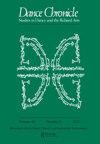大联合的灼热与跳跃的即兴世界
IF 0.1
3区 艺术学
0 DANCE
引用次数: 0
摘要
舞蹈评论家兼编辑Wendy Perron出版了一本名为《大联盟:市中心舞蹈的意外无政府主义者,1970-1976》的新书。即兴舞蹈组合Grand Union汇集了纽约市中心舞蹈界的一些关键人物——芭芭拉·迪利、道格拉斯·邓恩、大卫·戈登、史蒂夫·帕克斯顿、特里莎·布朗、南希·刘易斯和伊冯娜·雷纳——进行了六年的集体合作,期间他们进行了50多次即兴表演。Perron以内部人士的身份写道,她在20世纪70年代末的个人作品中与Trisha Brown跳舞,并在她作为纽约舞者和编舞家的漫长历程中与其他大联盟成员重叠。Perron曾几次观看Grand Union的演出,并于1976年写了一篇关于他们在La MaMa演唱会的评论,她在书中转载了这篇评论(第125-28页)。四十五年后,她重新审视了这篇最初的评论,并将其扩展为一本书长的手稿,试图捕捉她对这个即兴组合的热爱和学习。佩伦的书写得温暖而深情,是对大联盟的独特贡献以及她对他们工作的联系的思考。Perron所从事的辩论更多的是舞蹈批评,而不是学术文献,他们批评Grand Union的表演,声称该团体自我放纵、无聊、自恋和/或自我驱动。针对这些驳回,Perron提出了Grand Union对舞蹈即兴创作的具体方法,以及他们的作品对后现代舞蹈发展的更广泛影响。Perron在另一本关于乐团的书Margaret Hupp Ramsay的《大联盟》(1970–1976):即兴表演团体(1991)的基础上,添加了视频文件的描述并分析了团体表演的内容。佩伦的书中有许多照片,为了解大联盟在他们的表演中创造的世界提供了一扇窗户。本文章由计算机程序翻译,如有差异,请以英文原文为准。
The Searing and Fleeting Improvisational World of Grand Union
Dance critic and editor Wendy Perron has published a new volume titled The Grand Union: Accidental Anarchists of Downtown Dance, 1970–1976. The improvisational dance group Grand Union brought together some key figures within New York’s downtown dance scene—Barbara Dilley, Douglas Dunn, David Gordon, Steve Paxton, Trisha Brown, Nancy Lewis, and Yvonne Rainer—for a six-year period of collective collaboration during which they presented more than fifty improvised performances. Perron writes as an insider, having danced with Trisha Brown in her individual work in the late 1970s and overlapped with other Grand Union members in her long trajectory as a New York–based dancer and choreographer. Perron saw Grand Union perform on a handful of occasions and wrote a review in 1976 of their concert at La MaMa, which she reprints in her book (pp. 125–28). Forty-five years later, she revisits and expands this initial review into a book-length manuscript that endeavours to capture what she loved about and learned from this improvisational ensemble. Written with warmth and fondness, Perron’s book is a meditation on the distinct contribution of Grand Union and the connection she felt to their work. Engaging with dance criticism more than scholarly literature, the debates that Perron takes up are with dance critics who panned Grand Union’s performances, claiming that the group was self-indulgent, boring, narcissistic, and/or ego driven. Against these dismissals, Perron makes a case for Grand Union’s specific approach to dance improvisation and the wider influence of their work on the development of postmodern dance. Perron builds upon one other book about the ensemble, Margaret Hupp Ramsay’s The Grand Union (1970–1976): An Improvisational Performance Group (1991), by adding descriptions of video documents and analyzing the content of the group’s performances. Illustrated with many photographs, Perron’s book provides a window into the worlds that Grand Union created within their performances.
求助全文
通过发布文献求助,成功后即可免费获取论文全文。
去求助
来源期刊

DANCE CHRONICLE
DANCE-
CiteScore
0.40
自引率
0.00%
发文量
22
期刊介绍:
For dance scholars, professors, practitioners, and aficionados, Dance Chronicle is indispensable for keeping up with the rapidly changing field of dance studies. Dance Chronicle publishes research on a wide variety of Western and non-Western forms, including classical, avant-garde, and popular genres, often in connection with the related arts: music, literature, visual arts, theatre, and film. Our purview encompasses research rooted in humanities-based paradigms: historical, theoretical, aesthetic, ethnographic, and multi-modal inquiries into dance as art and/or cultural practice. Offering the best from both established and emerging dance scholars, Dance Chronicle is an ideal resource for those who love dance, past and present. Recently, Dance Chronicle has featured special issues on visual arts and dance, literature and dance, music and dance, dance criticism, preserving dance as a living legacy, dancing identity in diaspora, choreographers at the cutting edge, Martha Graham, women choreographers in ballet, and ballet in a global world.
 求助内容:
求助内容: 应助结果提醒方式:
应助结果提醒方式:


